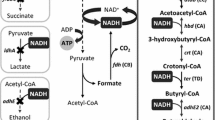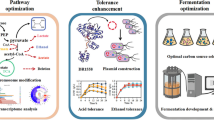Abstract
Many microorganisms could naturally produce (R, R)-2,3-butanediol ((R, R)-2,3-BD), which has unique applications due to its special chiral group and spatial configuration. But the low enantio-purity of the product hindered the development of large-scale production. In this work, a synthetic constitutive metabolic pathway for enantiomerically pure (R, R)-2,3-BD biosynthesis was constructed in Escherichia coli with vector pUC6S, which does not contain any lac sequences. The expression of this artificial constructed gene cluster was optimized by using two different strength of promoters (AlperPLTet01 (P01) and AlperBB (PBB)). The strength of P01 is twice stronger than PBB. The fermentation results suggested that the yield of (R, R)-2,3-BD was higher when using the stronger promoter. Compared with the wild type, the recombinant strain E. coli YJ2 produced a small amount of acetic acid and showed higher glucose consumption rate and higher cell density, which indicated a protection against acetic acid inhibition. In order to further increase the (R, R)-2,3-BD production by reducing the accumulation of its precursor acetoin, the synthetic operon was reconstructed by adding the strong promoter P01 in front of the gene ydjL coding for the enzyme of (R, R)-2,3-BD dehydrogenase which catalyzes the conversion of acetoin to (R, R)-2,3-BD. The engineered strain E. coli YJ3 showed a 20 % decrease in acetoin production compared with that of E. coli YJ2. After optimization the fermentation conditions, 30.5 g/L of (R, R)-2,3-BD and 3.2 g/L of acetoin were produced from 80 g/L of glucose within 18 h, with an enantio-purity over 99 %.





Similar content being viewed by others

References
Alper H, Fischer C, Nevoigt E, Stephanopoulos G (2005) Tuning genetic control through promoter engineering. Proc Natl Acad Sci U S A 102:12678–12683
Celinska E, Grajek W (2009) Biotechnological production of 2,3-butanediol—current state and prospects. Biotechnol Adv 27:715–725
Chen C, Wei D, Shi JP, Wang M, Hao J (2014) Mechanism of 2,3-butanediol stereoisomer formation in Klebsiella pneumoniae. Appl Microbiol Biotechnol 98:4603–4613
Chong L (2001) Molecular cloning—a laboratory manual, 3rd edition. Science 292:446
Dai JJ, Cheng JS, Liang YQ, Jiang T, Yuan YJ (2014) Regulation of extracellular oxidoreduction potential enhanced (R, R)-2,3-butanediol production by Paenibacillus polymyxa CJX518. Bioresour Technol 167:433–440
Fu J, Wang Z, Chen T, Liu W, Shi T, Wang G, Y-j T, Zhao X (2014) NADH plays the vital role for chiral pure D-(−)-2,3-butanediol production in Bacillus subtilis under limited oxygen conditions. Biotechnol Bioeng 111:2126–2131
Ji X-J, Huang H, Ouyang P-K (2011) Microbial 2,3-butanediol production: a state-of-the-art review. Biotechnol Adv 29:351–364
Ji X-J, Liu L-G, Shen M-Q, Nie Z-K, Tong Y-J, Huang H (2015) Constructing a synthetic metabolic pathway in Escherichia coli to produce the enantiomerically pure (R, R)-2,3-butanediol. Biotechnol Bioeng 112:1056–1059
Kim KJ, Kim HE, Lee KH, Han W, Yi MJ, Jeong J, Oh BH (2004) Two-promoter vector is highly efficient for overproduction of protein complexes. Protein Sci 13:1698–1703
Kim D-K, Rathnasingh C, Song H, Lee HJ, Seung D, Chang YK (2013) Metabolic engineering of a novel Klebsiella oxytoca strain for enhanced 2,3-butanediol production. J Biosci Bioeng 116:186–192
Li Z-J, Jian J, Wei X-X, Shen X-W, Chen G-Q (2010) Microbial production of meso-2,3-butanediol by metabolically engineered Escherichia coli under low oxygen condition. Appl Microbiol Biotechnol 87:2001–2009
Li L, Li K, Wang Y, Chen C, Xu Y, Zhang L, Han B, Gao C, Tao F, Ma C, Xu P (2015) Metabolic engineering of Enterobacter cloacae for high-yield production of enantiopure (2R,3R)-2,3-butanediol from lignocellulose-derived sugars. Metab Eng 28:19–27
Lu C, Jeffries T (2007) Shuffling of promoters for multiple genes to optimize xylose fermentation in an engineered Saccharomyces cerevisiae strain. Appl Environ Microb 73:6072–6077
Sadhu KM, Matteson DS, Hurst GD, Kurosky JM (1984) (R,R)-2,3-Butanediol as chiral directing group in the synthesis of (Alpha-S)-Alpha-chloro boronic esters. Organometallics 3:804–806
Sandoval NR, Mills TY, Zhang M, Gill RT (2011) Elucidating acetate tolerance in E. coli using a genome-wide approach. Metab Eng 13:214–224
Snoep JL, Yomano LP, Westerhoff HV, Ingram LO (1995) Protein burden in Zymomonas mobilis: negative flux and growth control due to overproduction of glycolytic enzymes. Microbiology 141:2329–2337
Ui S, Masuda T, Masuda H, Muraki H (1986) Mechanism for the formation of 2,3-butanediol stereoisomers in Bacillus polymyxa. J Ferment Technol 64:481–486
Ui S, Okajima Y, Mimura A, Kanai H, Kudo T (1997) Molecular generation of an Escherichia coli strain producing only the meso-isomer of 2,3-butanediol. J Ferment Bioeng 84:185–189
Ui S, Takusagawa Y, Sato T, Ohtsuki T, Mimura A, Ohkuma M, Kudo T (2004) Production of L-2,3-butanediol by a new pathway constructed in Escherichia coli. Lett Appl Microbiol 39:533–537
Vieira J, Messing J (1991) New pUC-derived cloning vectors with different selectable markers and DNA replication origins. Gene 100:189–194
Xu Y, Chu H, Gao C, Tao F, Zhou Z, Li K, Li L, Ma C, Xu P (2014) Systematic metabolic engineering of Escherichia coli for high-yield production of fuel bio-chemical 2,3-butanediol. Metab Eng 23:22–33
Yan Y, Lee C-C, Liao JC (2009) Enantioselective synthesis of pure (R,R)-2,3-butanediol in Escherichia coli with stereospecific secondary alcohol dehydrogenases. Org Biomol Chem 7:3914–3917
Zeng A-P, Sabra W (2011) Microbial production of diols as platform chemicals: recent progresses. Curr Opin Biotechnol 22:749–757
Acknowledgments
This work was financially supported by the National Science Foundation for Distinguished Young Scholars of China (No. 21225626), the National Natural Science Foundation of China (Nos. 21376002, 21476111), the Jiangsu Provincial Natural Science Foundation of China (No. BK20131405), and the Priority Academic Program Development of Jiangsu Higher Education Institutions.
Conflict of interest
The authors declare that they have no competing interests.
Author information
Authors and Affiliations
Corresponding authors
Rights and permissions
About this article
Cite this article
Tong, YJ., Ji, XJ., Shen, MQ. et al. Constructing a synthetic constitutive metabolic pathway in Escherichia coli for (R, R)-2,3-butanediol production. Appl Microbiol Biotechnol 100, 637–647 (2016). https://doi.org/10.1007/s00253-015-7013-3
Received:
Revised:
Accepted:
Published:
Issue Date:
DOI: https://doi.org/10.1007/s00253-015-7013-3



